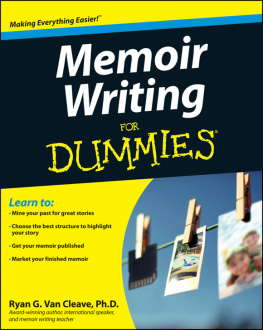Writing for Others,
Writing for Ourselves
Writing for Others,
Writing for Ourselves
Telling Stories in an Age of Blogging
Jerry Lanson

Published by Rowman & Littlefield Publishers, Inc.
A wholly owned subsidiary of The Rowman & Littlefield Publishing Group, Inc.
4501 Forbes Boulevard, Suite 200, Lanham, Maryland 20706
http://www.rowmanlittlefield.com
Estover Road, Plymouth PL6 7PY, United Kingdom
Copyright 2011 by Rowman & Littlefield Publishers, Inc.
All rights reserved. No part of this book may be reproduced in any form or by any electronic or mechanical means, including information storage and retrieval systems, without written permission from the publisher, except by a reviewer who may quote passages in a review.
British Library Cataloguing in Publication Information Available
Library of Congress Cataloging-in-Publication Data
Lanson, Jerry.
Writing for others, writing for ourselves : telling stories in an age of blogging / Jerry Lanson.
p. cm.
Includes bibliographical references and index.
ISBN 978-0-7425-5534-1 (cloth : alk. paper) ISBN 978-1-4422-0869-8 (electronic)
1. Authorship. 2. AuthorshipVocational guidance. I. Title.
PN145.L26 2010
808.02dc22 2010028863
 The paper used in this publication meets the minimum requirements of American National Standard for Information SciencesPermanence of Paper for Printed Library Materials, ANSI/NISO Z39.48-1992. Printed in the United States of America
The paper used in this publication meets the minimum requirements of American National Standard for Information SciencesPermanence of Paper for Printed Library Materials, ANSI/NISO Z39.48-1992. Printed in the United States of America
CONTENTS
PREFACE
The stories in this book begin in the bucolic French countryside. They wrap up in a crowded, multinational refugee resettlement complex near Atlanta, Georgia. Some are humorous; others, sad. Many fall in between. What connects them is the personal, human ingredient most good storytelling shares.
This is a book for those who hunger to tell true storiesnonfiction stories, their own, and others. I suspect most people do. Still, many are wary, perhaps overwhelmed, at how to begin. Theyve been crippled by their eighth-grade English teachers comments or cowed after reading a cutting Sunday book review. Or their minds have been cluttered by a culture that celebrates the hyperbolic and the frenetic.
Writing ultimately starts with an act of will. It can be a struggle; I know from personal experience. It also can be a joy. I hope the pages of this book convey a bit of both. In them, Ill share a method that, over three decades in classrooms and even longer in the silence of my office, has helped my students and me overcome the misery of that ill-defined nemesis: writers block.
In the three-plus years its taken to write these words, a tsunami has transformed the world of nonfiction storytelling. It continues to crash ashore. Traditional outlets of storytellingbook publishers, magazines, and newspapershave seen their staffs shrink and, in some cases, their doors close. Meanwhile, that amoeba-like monster called the blogosphere has continued to extend its reach.
Estimates of Weblog (blog) use vary widely and are constantly in flux. But as Technorati.com, which issues annual reports on the blogosphere, noted in August 2009, All studies agree... that blogs are a global phenomenon that has hit the mainstream. In that same State of the Blogosphere report, Technorati referenced one global survey that estimates 184 million people worldwide had started a blog.
In another report, Bloggers: A Portrait of the Internets New Storytellers, released in July 2006, the Pew Internet and American Life Project
Some would dismiss this new world of self-publishing with a sniffle or sneer. And no doubt it is filled with its share of mindless ranters and me-centric preeners. However, it also offers perhaps the most remarkable practice stage for storytelling ever created.
Starting a blog and sustaining it are two different matters. And countless thousands of teens and young adults who started blogs to communicate with friends have since abandoned them in favor of social media sites such as Facebook.
Yet, in its February 2010 report titled Social Media and Young Adults, Pew found that the number of American adults over thirty who are blogging continues to grow, from 7 percent in 2006 to 11 percent in 2009, closing the gap on teenage (14 percent) and young adult (15 percent) bloggers.
THE PROMISE OF BLOGGING
Numbers aside, the promise of blogs as a storytelling tool remains formidable, as I was reminded again in writing one of the final chapters of this book. Thats when I came across a remarkable series conceived and written by Mary Wiltenburg, a talented reporter with whom I worked as a writing coach at the Christian Science Monitor nearly a decade ago. Relying in part on a reporting grant from the Pulitzer Center on Crisis Reporting, she set out to tell the story of Little Bill Clinton Hadam, a Tanzanian refugee living in Atlanta and attending an international charter school where he was enrolled in the third grade.
Narrative projects, even those that last a year, are deeply rooted in American traditions of journalism. What made Wiltenburgs different was her commitment to producing it in real time, placing nearly daily blogs at the projects soul. She had never been a blogger or much of a blog reader. I found them overwritten and self-absorbed, she said. Yet, as a young woman in her early thirties, she knew people who rarely picked up a magazine or newspaper yet spent hours reading blogs and social media posts. It struck me, she said, that what worked there was a tiny episodic narrative over time.
And so, even before she had locked in a subject, she conceived a project that would combine monthly longer-form traditional print journalism with real-time blogs, most written, some recorded and videotaped. My hope was to do something that really followed a story in an intimate, multimedia way that would unfold over time so that readers could participate, she explains on her Web page, http://wiltenburg.wordpress.com .
of this book.
Wiltenburg finished the project with a newfound respect for blogging and its role in storytelling. I loved doing the blog and the stories, she recalls. There was so much that you couldnt put in the stories.... It was wonderful to have [the blog] for all the small moments. It was a place I could cut loose a little bit, but also reflect.
It was also a place she could connect with her readers. Here is one of the series early blogs, about the day she met Dawami Lenguyanga, Bills Rwandan-born mother and a central figure in the series.
I had known Bills mom for three hours when I asked her if she had friends in Atlanta.
You, she said.
Wed started the afternoon as strangers, stiff and shy, sitting around with her husband, watching Tanzanian music videos about the coming of the apocalypse. When he left to rest up for his night shift, Dawami got chatty....
In Tanzania she had had friends, she explained, but Atlanta one-and-half year no friend. Now you friend.
She grinned, and I thanked her, and put my hand over my heart.
And though Ive since learned that she does have one or two other women friends heretheyre African, so she calls them sistersand though weve since had extensive conversations, with and without a professional interpreter, about journalism and what that means, I worried then, and I still worry, about the scope of her loneliness, the immediacy and completeness of her trust in me, and how to deserve that trust. Starting today, and for the next year, this project is my attempt to be worthy of it.
Next page













 The paper used in this publication meets the minimum requirements of American National Standard for Information SciencesPermanence of Paper for Printed Library Materials, ANSI/NISO Z39.48-1992. Printed in the United States of America
The paper used in this publication meets the minimum requirements of American National Standard for Information SciencesPermanence of Paper for Printed Library Materials, ANSI/NISO Z39.48-1992. Printed in the United States of America